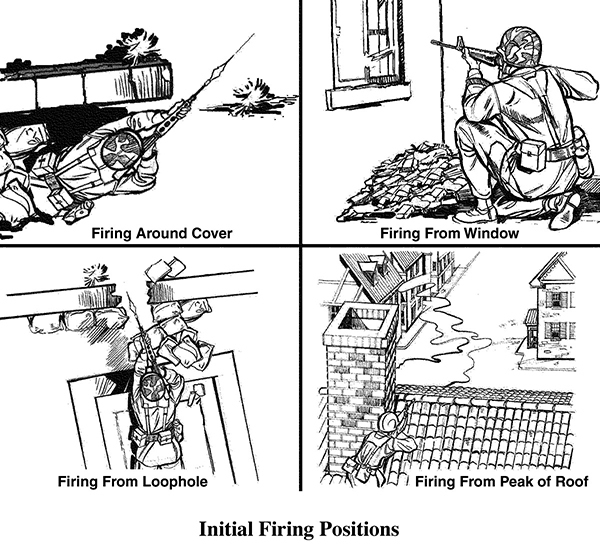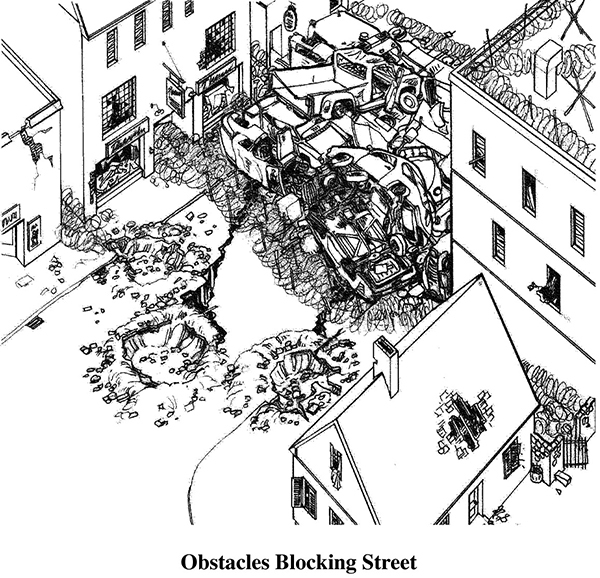Take care that the teams do not get out of the range or ability of the support by fire element. Also be careful that the team does not get separated in the building, which can lead to confusion and fratricide.
Step 8. Upon a slowdown in the action, the squad leader will radio back to higher headquarters (HHQ) to inform them of the situation. He should convey the following:
•Report to the platoon leader that the squad has entered the building and seized a foothold.
•Ammo, casualties, and equipment (ACE) report to HHQ and report if medical support or resupply is needed.
•Inform HHQ of the unit’s exact location and what identify friendly forces (IFF) markings are being used to limit fratricide.
•Determine location of the CCP and continue to direct the assault.
Step 9. The squad leader directs the team in where to clear next if momentum starts to slow down. The squad leader also constantly confirms that all areas are cleared and secure IAW the unit SOP.
Step 10. The squad consolidates its position in the building and then reorganizes as necessary. All sub-unit leaders pass on ACE reports. Note: Normally the squad or platoons will use large-caliber weapons (if available) to suppress enemy in adjacent buildings.
Consolidation and Reorganization
The squad and platoon will conduct consolidation and reorganization immediately after each action in which soldiers are engaged and ammunition is expended. Consolidation in an urban environment must be quick in order to repel enemy counterattacks and to prevent the enemy from infiltrating back into cleared areas. Immediate tactical reloads by any soldiers that expended any amount of rounds should take place, and ACE reports should be passed up the chain of command.
Reorganization occurs after consolidation. These actions prepare the unit to continue the mission by ensuring key leadership positions are filled and important weapon systems are manned. Many reorganization actions occur simultaneously during the consolidation of the objective. For more information on consolidation and reorganization, see Chapters 4 and 5.
DEFENSIVE OPERATIONS IN URBAN AREAS
This section covers the basic planning considerations, weapons selection, preparations, and the construction of a platoon defensive position on urbanized terrain.
Planning the Defense
Leaders plan an urban defense that uses terrain wisely, designates a point of main effort, uses defensive positions that force the enemy to make costly attacks or conduct time-consuming maneuvers to avoid them, and achieves surprise. They must consider civilians, ROE, limited collateral damage, and coordination with adjacent units to eliminate the probability of fratricide.
The squad’s and platoon’s focus for defending in an urban area is the retention of terrain. The platoon will be given either an AO to defend or a battle position to occupy. By using the terrain and fighting from well-prepared and mutually supporting positions, a defending force can delay, block, fix, or inflict heavy losses on a much larger attacking force.
In urban operations, the platoon is often a strongpoint defense of a building, part of a building, or a group of small buildings that is normally integrated into the company’s mission. Weapon systems and personnel are positioned to maximize their capabilities. Supporting fires are incorporated into the overall defensive plan to provide depth to the engagement area (EA). The platoon leader organizes the defense into a series of individual, team, and squad fighting positions located to cover avenues of approach and obstacles and to provide mutual support to repel the enemy advance.
The platoon and squad leader have only two choices in an urban defense—hasty or deliberate. Having time to plan and prepare and knowledge of the enemy is really the only difference between a hasty and deliberate defense. All of the troop-leading procedures (TLPs) are the same, as well as many of the priorities of work, and the two types may even take place concurrently. Units are deployed, key weapons emplaced, and fighting positions prepared in accordance with the amount of time available to the unit.
Occupation and Preparation of Positions
Normally, when occupying defensive positions, the platoon takes advantage of the cover and concealment already present and continues to make improvements to the positions given more time and materials.
The platoon first positions crew-served weapons. Normal defensive priorities of work apply (see Chapter 5). Fighting positions in buildings are constructed in the shadows of the room, away from windows and other openings, using appliances, furniture, and other convenient items and materials. Some of the more common fighting positions in an urban area are corners of buildings, behind walls, windows, unprepared loopholes, and the peak of a roof.

Urban Priorities of Work. In addition to general defensive priorities of work, special attention is to be given the following in the urban environment:
1.Select key weapons positions for Javelins, AT-4s (Gustavs), and M240B MGs to cover likely mounted and dismounted avenues of approach. Position the Javelins where flank engagements will occur inside buildings with adequate space and ventilation for backblast (on upper floors, if possible, for long-range shots). Position squad automatic weapons (SAWs) and machine guns (MGs) near ground level to increase grazing fires or on upper levels if ground rubble obscures grazing fire.
2.Ensure the positions are free of noncombatants. Remove them from the AOs before occupation of the position.
3.Clear fields of fire by using loopholes, aiming stakes, sector stakes, and TRP markings. Construct positions with overhead cover and camouflage (inside and outside).
4.Identify and secure subterranean avenues of approach (sewers and basements) as well as stairwells and rooftops.
5.Stockpile ammunition, food, fire-fighting equipment, and drinking water throughout the depth of your defense.
6.Construct barriers and emplace obstacles to deny the enemy access to streets, underground passages, and buildings, and to slow his movement. Erect the obstacles in an irregular pattern to hinder enemy movement. Employ the obstacles in depth (if possible). Tie the obstacles in with existing ones and cover all of them with fire and observation.
7.Improve and mark movement routes between positions and to alternate and supplementary positions. An escape route to fallback positions is essential to an adequate defense. This is accomplished by digging trenches, using sewers and tunnels, creating mouseholes, and emplacing ropes for climbing and rappelling and ladders for ascent and descent.
Additional defensive preparation tasks may be required in basements, on ground floors, and on upper floors.

Basements and Ground Floors. Basements and ground floors require similar preparation. Any underground system not used by the defender that could provide enemy access to the position must be blocked. Unused doors should be locked or nailed shut, as well as blocked and reinforced with furniture, sandbags, or other field expedients. If not required for the defender’s movement, hallways should be blocked with furniture and tactical wire. Unused stairs should be blocked with furniture and tactical wire or removed. If possible, all stairs should be blocked and ladders should be used to move from floor to floor and then removed. Remove all window glass and block unused windows with boards or sandbags to prevent observation and access. Make fighting positions in the floors. If there is no basement, fighting positions can give additional protection from heavy direct-fire weapons. Erect support for ceilings that cannot withstand the weight of rubble from upper floors. Block rooms not required for defense with tactical wire.